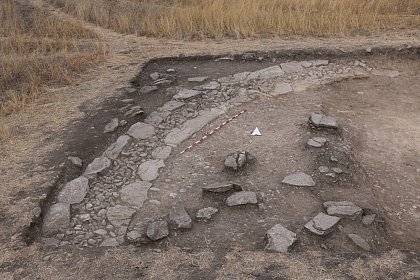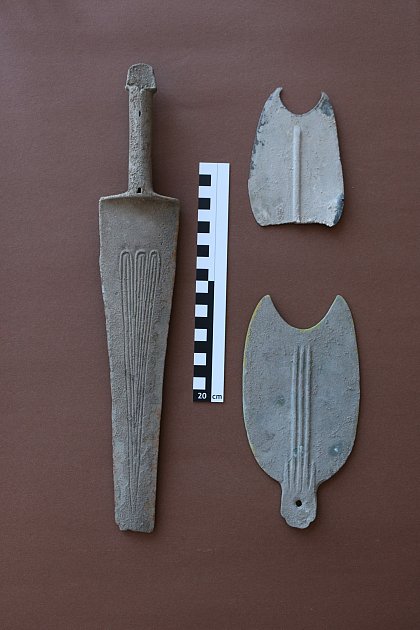Rundbau auf der Kuppe

Fig. 1: View of the sanctuary of Nazarlebi from the south (photo G. Kirkitadze). Plateau sections (PS) 3 and 5 in front, PS 2 and 4 in the back (from the west).
The area left out by the excavation contains the concreted trigonometric point.
In the year 2018, two areas were opened on the central plateau ("Plateau trench 1 and 2"). The eastern trench revealed various stone settings, which can be roughly divided into two phases. The younger one was already visible in small sections on the surface. In the western area of the plateau ("Plateau trench 2"), irregular stone settings were also visible on the surface. During their excavation the first bronze deposit was found (Deposit 1).

Fig. 2: North-western course of the wall. The double-shell masonry can be seen clearly, with a well-laid infill in between.
The wall is circular and the stone circle has a diameter of about 19 m and is approximately round (Fig. 6). The two-shell wall has been found practically everywhere only in a single layer and consists of slabs and blocks of different sizes and materials.
Only in two places is the masonry still preserved, consisting of slabs or stones lying on the two-shell wall; the latter come from the material found on the hill and in the surrounding area. There are also various layers of stone, especially outside the ring of the wall, which may be interpreted as fallen stones.
Inside the stone circle, further finds were found that cannot be assigned to another depot: A small bronze double axe is slightly deformed and shows a good and a bad half of the blade. The points face the shaft hole; there is a triangular widening with a central ridge.
In addition, a sword as well as a whole and a fragmentary "razor" (Fig. 5), all three well comparable with the pieces found in DF 1. The completely preserved razor shows different groove decoration, in that once in addition to the three grooves there are two short points emerging from the edge of the handle. Here, too, the two cutting edges are sharp. The same applies to the fragmentary piece, which has a central burr.
Two clay bread stamps (and a few fragments of such) were also found, a round one with two interlocking spirals and a rectangular one with one central and four outer elements arranged in a clockwise tordate fashion.
Also worth mentioning are a long, carefully crafted flat stone pendant and four serrated flint blades. The latter were all found seperate.

Fig. 3: Finds from the stone circle including a fragmented sword and two "razors".
The similarity with the East Georgian sanctuary of Shilda in the Alasani Valley is obvious, both in terms of architecture and finds. The dating to the Late Bronze Age or Early Iron Age (c. 12th-9th century BC), which results from the depot finds and the abundant pottery, also fits well into this picture.




